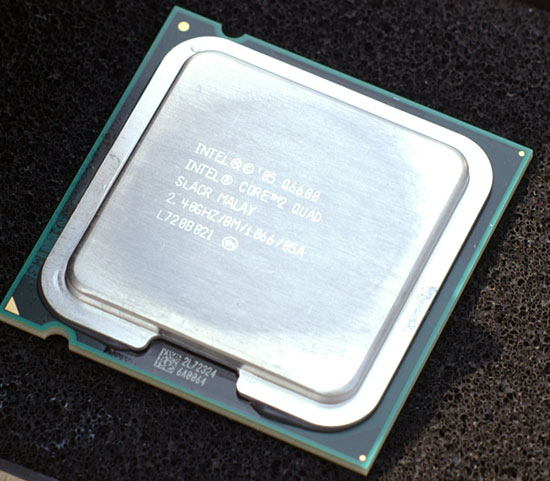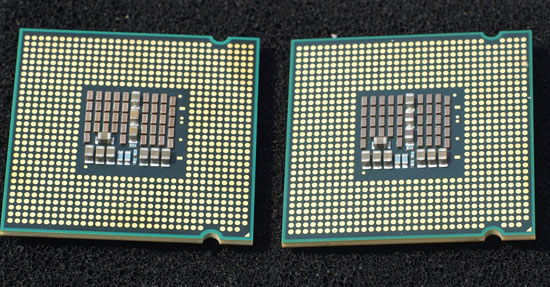Intel Core 2 Q6600 G0 Stepping: Cheap Quad Core Just Got Better
by Anand Lal Shimpi on August 16, 2007 11:53 AM EST- Posted in
- CPUs
Last month's price cuts not only made it tempting to build a new PC today, but they also brought quad-cores within the reach of mid-range budget systems.
| CPU | Clock Speed | FSB | L2 Cache | Availability | Pricing |
| Intel Core 2 Extreme QX6850 | 3.00GHz | 1333 | 4MBx2 | Now | $999 |
| Intel Core 2 Extreme QX6800 | 2.93GHz | 1066 | 4MBx2 | Now | $999 |
| Intel Core 2 Quad Q6700 | 2.66GHz | 1066 | 4MBx2 | Now | $530 |
| Intel Core 2 Quad Q6600 | 2.40GHz | 1066 | 4MBx2 | Now | $266 |
| Intel Core 2 Duo E6850 | 3.00GHz | 1333 | 4MB | Now | $266 |
| Intel Core 2 Duo E6750 | 2.66GHz | 1333 | 4MB | Now | $183 |
| Intel Core 2 Duo E6550 | 2.33GHz | 1333 | 4MB | Now | $163 |
| Intel Core 2 Duo E6540 | 2.33GHz | 1333 | 4MB | Now | $163 |
| Intel Core 2 Duo E4600 | 2.40GHz | 800 | 2MB | Q4 | $133 |
| Intel Core 2 Duo E4500 | 2.20GHz | 800 | 2MB | Q3 | $133 |
| Intel Core 2 Duo E4400 | 2.00GHz | 800 | 2MB | Now | $113 |
| Intel Pentium E2180 | 2.00GHz | 800 | 1MB | Q4 | $84 |
| Intel Pentium E2160 | 1.80GHz | 800 | 1MB | Now | $84 |
| Intel Pentium E2140 | 1.60GHz | 800 | 1MB | Now | $74 |
For $266 you now have a tough decision to make: do you buy two 3.0GHz cores or four 2.40GHz cores? In our last review we found that if you're doing any amount of 3D rendering or media encoding, the Core 2 Quad Q6600 at $266 ends up being the better value. Of course, if you want the best of both worlds you could always overclock the 2.40GHz Q6600, giving you four, much faster cores.
Hitting the S-Spec
In between major architectural revisions of processors, a core will go through multiple revisions or steppings. These steppings can be simple manufacturing tweaks, allowing for cooler operation, or they can include bug fixes and slight performance improvements. Performance improvements are rarely tangible, if even measurable in most cases, but the point is that these cores evolve over time. AMD and Intel learn better, more efficient ways to produce the chips over the lifetime of the processors and they incorporate the learnings into later revisions of the processors.
The original Core 2 processors that launched in July of last year were stepping B1, they were later replaced by a B2 stepping. Intel quietly introduced a new core with only 2MB of L2 cache (instead of 4MB with only half enabled), and thus we gained two more steppings: L2 and M0. The quad-core processors use a slightly different core stepping as well: B3. More recently, Intel introduced yet another revision to its Core 2 microprocessors: the G0 stepping.
G0 fixes a handful of bugs, but most of them were minor and or have software workarounds in play. The more noticeable aspect of G0 is its lower power consumption, which some have proposed as meaning G0 cores may be better overclockers.
Only a subset of Intel processors are presently available with G0 stepping cores: the Core 2 Duo E6540, E6550, E6750, E6850, Q6600, Q6700, QX6800 and QX6850. Of those listed, the E6540, E6550, E6750, E6850 and QX6850 are only available in G0, while the remainder are offered in B2 or B3 as well.
How do you know what stepping you've got? CPU-Z will tell you exactly what you're running, but you can also look at the CPU itself or the box it came in if you've got a retail chip.
Intel encodes the core stepping, cache size, frequency, package, FSB and more into a five character code called an S-Spec. You can use Intel's Processor Finder to decode almost any S-Spec, although there are some limitations.
The new G0 stepping chips have the following S-Specs:
| S-Spec | Core Stepping | CPU |
| SLAFN | G0 | QX6850 |
| SLACP | G0 | QX6800 |
| SLACQ | G0 | Q6700 |
| SLACR | G0 | Q6600 |
| SLAA5 | G0 | E6540 |
| SLA9X | G0 | E6550 |
| SLA9V | G0 | E6750 |
| SLA9U | G0 | E6850 |
Here we have the new G0 based SLACR S-Spec on a processor box:

...and on the Q6600 itself:

Some vendors will even go as far as to hand select only G0 processors, advertising them as such. The question we're here to answer is whether or not the G0 based Q6600, (S-Spec: SLACR), is noticeably better than its B3 predecessor (S-Spec: SL9UM).

The G0 based SLACR (left) and the B3 based SL9UM (right)
Test Configuration
| CPU: | Intel Core 2 Quad Q6600 (2.40GHz/1066MHz) B3 Intel Core 2 Quad Q6600 (2.40GHz/1066MHz) G0 Both chips used the same VID |
| Motherboard: | Gigabyte GA-P35C-DS3R (Intel P35) |
| Chipset: | Intel P35 |
| Chipset Drivers: | Intel 8.1.1.1010 (Intel) |
| Hard Disk: | Seagate 7200.9 300GB SATA |
| Memory: | Corsair XMS2 DDR2-800 4-4-4-12 (1GB x 2) |
| Video Card: | NVIDIA GeForce 8800 GTX |
| Video Drivers: | NVIDIA ForceWare 158.18 |
| Desktop Resolution: | 1600 x 1200 |
| OS: | Windows Vista Ultimate 32-bit |










34 Comments
View All Comments
gigahertz20 - Thursday, August 16, 2007 - link
Anand,Your overclocking results mean nothing if you don't list what type of cooling you used? Stock Intel cooler? Tuniq Tower 120? Thermalright Ultra-120 Extreme? Typhoon VX? Zalamn? Scythe? Noctua? The only thing you said was "our max was 3.51GHz (390 x 9.0) without resorting to improved cooling" so by that statement I'm assuming you must have been using air but which HSF?
How can you miss this? Indians aren't supposed to make mistakes, just kidding :) We're all human.....at least I think :)
Anand Lal Shimpi - Thursday, August 16, 2007 - link
Sorry, I thought I mentioned that I was using the stock Intel HSF. :)Take care,
Anand
Roy2001 - Friday, August 17, 2007 - link
Could you try a better HSF? ATers whwant to OC this beast would avoid stock HSF I believe.Omega215D - Thursday, August 16, 2007 - link
He was just being a SLACR...:ducks:
vijay333 - Thursday, August 16, 2007 - link
Could you also comment on whether there were any noticeable differences between the CPUs with regards to temps? Kinda related to the wattage of course, but actual idle/load temperature values would help too. Thanks.aka1nas - Thursday, August 16, 2007 - link
I didn't see listed which board was used to test overclockability of the two chips. Lots of boards still have issues with clocking G0s to high FSB speeds, especially at a 9x multi as the previous poster mentioned.Anand Lal Shimpi - Thursday, August 16, 2007 - link
Sorry, I updated the article with the test table. I used the Gigabyte GA-P35C-DS3R.Take care,
Anand
ChronoReverse - Thursday, August 16, 2007 - link
I have two G0's and it seems there's a great deal of variation even for two CPUs in the same batch.You should check the VID (using Core Temp) of the CPU. A lower VID means Intel rated the CPU to run at stock with a lower voltage, generally meaning more overclocking headroom. Of my two G0 Q6600's, one was 1.3125V while the other was 1.2750V.
Also, the 9X multiplier is harder to overclock on than lower multipliers (for reasons unknown to me but I've encountered it myself as well as read other people commenting thus). My 1.3125V Q6600 can boot and run at 3.6GHz (450x8) almost stably (it can Prime95 all four cores for at least 20 minutes) but trying to do the same at 400x9 will always fail. I know that 400MHz FSB works since I can boot at 400x8, so I'm assuming the other factor would be the multiplier.
Dainas - Saturday, August 18, 2007 - link
Would it be possible to get a VID of 0.8250v? As that it what Core Temp reads for my G0 Q6600, but I have doubts as the the accuracy as I'm x64 Vista and Core temp cannot find the temps (the rest of the read stats check out though).Also CPU-z reads its default Voltage as being around 1.18v.
Darkmatterx76 - Thursday, August 16, 2007 - link
Since OC potential varies so much with these CPU's are there any companies that test the CPU's they buy from Intel/AMD and sort them based on the OC potential they have? Memory companies often test and sort their memory and package them according to their quality. It would be nice to get a CPU that's been tested for better then average OC potential without having to pay $1000 for an Extreme brand CPU. I wouldn't mind paying a little bit more for a Q6600 that I knew had some good OC room.